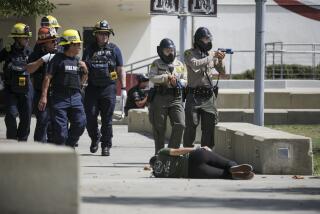California’s Schoolhouse Child Abuse: New Law Would Stop Student Beatings
SAN FRANCISCO — In most California school districts, the law allows teachers to hit their students. This holdover from our past would be abolished by a bill approved by both houses of the Legislature and now on Gov. George Deukmejian’s desk for signature.
During Colonial days, corporal punishment was a preferred method of handling school disciplinary problems, and teachers were expected to strike students regularly for any and all infractions. Some religious groups advocated the practice of regular corporal punishment at home and in school, in the belief that one could “beat the devil” out of recalcitrant children.
During the late 19th Century, several heavily publicized cases of child abuse resulted in the formation of child-protection organizations, and opposition mounted to the use of corporal punishment as a disciplinary method by schools. Gradually more humane forms of discipline were instituted as enlightened educators came to believe that punishment was unnecessary to maintain order.
Today, advocates for children maintain that the use of force in our schools is sanctioned child abuse--and the only officially approved form of physical abuse that remains in this country.
Along with my pediatric colleagues and a host of other organizations, I support the concept that there are alternatives to corporal punishment. Soldiers, prisoners and young people under the control of the California Youth Authority are protected against corporal punishment. School children, who are least able to defend themselves, are not. Six states--Hawaii, Maine, Massachusetts, New Hampshire, New Jersey, Rhode Island and Vermont--have outlawed corporal punishment, along with a number of U.S. cities, including Chicago, New Orleans, New York, San Francisco and Washington.
Many public school districts and private and religious schools in California still give overt or tacit approval to corporal punishment--not just spanking by hand or paddle, but also such methods as striking students with sticks, ropes, fists or belts; choking, throwing them against walls or desks; dragging them by the hair or arm; tying them to chairs; forcing them to do strenuous exercises (innumerable push-ups, laps around the track) for such infractions as being late to physical-education classes, and confining them to closets, vaults, storerooms and boxes.
Corporal punishment can potentially cause such injuries as hematomas, ruptured blood vessels, nerve damage, muscle damage, fractures and brain hemorrhages, and could result in permanent damage and disability.
Equally harmful, and much more common than the physical effects, are the psychological effects of corporal punishment: loss of self-esteem, increased anxiety and fear, feelings of helplessness and humiliation, aggressive and self-destructive behavior, limited attention span--all of which may lead to deficient academic performance.
Discipline and punishment are often confused. Discipline implies a learning relationship between teacher and pupil. Physical punishment may achieve some short-term goals, but may also teach students that the strong may use physical punishment to control others--that violence is an acceptable form of behavior.
The primary objective of our schools is to prepare students to become healthy, productive adults. Research on the effects of corporal punishment on the learning process indicates that such punishment is counterproductive and increases destructive behavior, hinders learning, is ineffective in maintaining order and develops aggressive hostility.
A more effective approach involves positive discipline, incorporating activities that help teachers and administrators assume control and establish order, with the cooperation of students. Students should be rewarded for controlling themselves and should be participants in the disciplinary process. That would improve communication and help develop mutual respect between students and administrators. Students need to assume control of their behavior and take responsibility for their actions.
When positive discipline fails, however, there are non-corporal alternatives--detention, chores, expulsion, discussion with students and parents, withdrawal of privileges, counseling, verbal reprimands and isolation of the student from the situation.
Those who publicly defend corporal punishment minimize the frequency of its use, insist that corporal punishment is kept in reserve only as a last-ditch method against incorrigible hoodlums. But the smallest children, toddlers to preteens, are likely to be the preferred targets of teachers and administrators who hit. Hoodlums are much harder to control; even the most macho school paddlers hesitate to strike students who have grown big enough to strike back.
Deukmejian’s signature on Assembly Bill 1617, sponsored by Assemblyman Sam Farr (D-Carmel), would emphasize that violence is not an acceptable way for teachers to resolve conflict. Corporal punishment has no place in our schools, and should be banned everywhere in this country. If the governor signs the bill, California will join a growing number of cities and states that share this belief.
More to Read
Sign up for Essential California
The most important California stories and recommendations in your inbox every morning.
You may occasionally receive promotional content from the Los Angeles Times.










